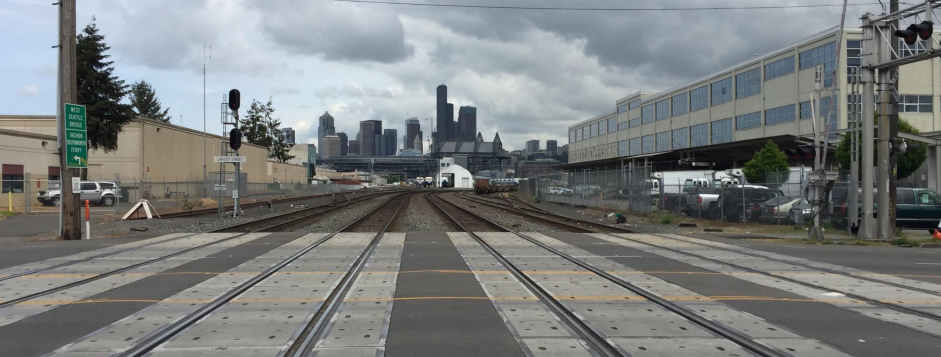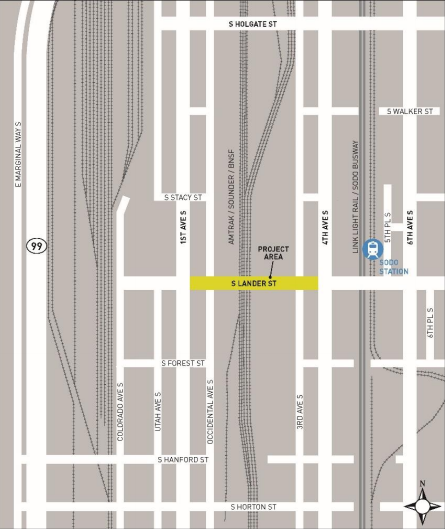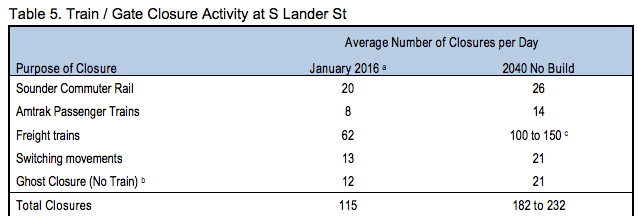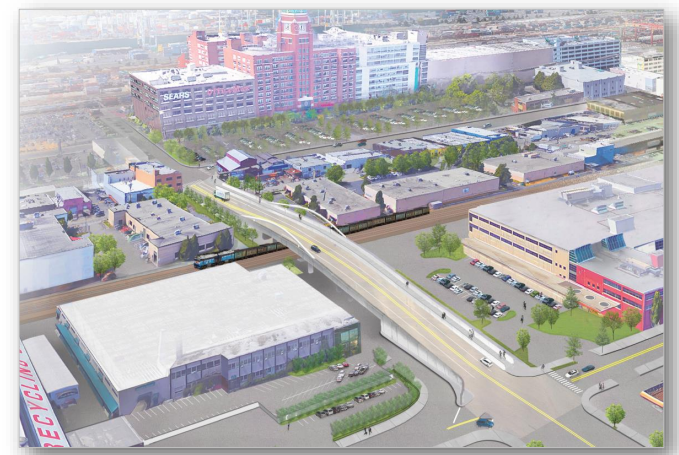In 2008, Seattle transportation officials made a tough decision: divert money that was previously allocated for a major corridor improvement project to another area that was proving itself to be a higher priority: Mercer Street. With South Lake Union looking like it was about to explode, as it did, then-mayor Greg Nickels and the Seattle Department of Transportation (SDOT) decided to pull the funds onto the project where it was most needed.
The project that ended up getting put back on the shelf as a result was the South Lander Street grade separation project. This would create a bridge over the Amtrak and freight rail tracks south of King Street Station on top of existing Lander Street from 1st Ave S to 4th Ave S. Original plans last decade show the project costs for grade-separating Lander at $38 million in YOE (year of expenditure) dollars. Total costs for the project are now at $140 million. Last year, Senator Maria Cantwell (D-Washington) announced that the project would be the recipient of the largest single grant ever awarded by the federal government to Washington state: $45 million dollars. When announcing the grant, the Senator said, “At Lander Street alone, Washington state loses $9.5 million a day in economic activity because of train, truck, and urban traffic congestion.” The Urbanist contacted her office to determine the source of that $3.5 billion per year in lost economic activity but has not received a response.

The federal budget proposal released by the Trump Administration this month, while only an opening salvo before Congress lays into it and legislative sausage gets made from it, lays out a clear direction for the direction of federal funding in contrast with the Obama Administration. Projects such as Madison BRT, the Center City Connector streetcar, and Sound Transit projects, both ST2 and ST3, are all depending on federal matching dollars to reach completion and are now very much in jeopardy after being removed from the President’s budget proposal. Despite the fact that the final contract has not been signed between the federal government and the City on Lander, the funding for the FASTLANE grant remains in the proposed budget. Lander’s federal portion appears safe–for now.
However, Seattle’s leaders are about to have some tough choices to make with regard to what our local dollars are used to build. Lander’s local funding sources include $5 million from real estate excise taxes (REET) and $8 million from the sale of the Pacific Place Garage. With $27.5 million still being searched for in the couch cushions on this project, it is time to take a step back, for the City to take a longer view with what is happening with our boomtown dollars, now that the federal well shows clear signs of drying up.

In addition, Seattle is now under attack by the Trump Administration for remaining a sanctuary city. The message from Attorney General Jeff Sessions this week was: want federal grant dollars? Not if you’re a sanctuary city. Local leaders have suggested they are prepared to take that deal, with Mayor Ed Murray on Monday issuing the following statement: “I’m willing to risk losing every penny of federal funding to stand by our commitment to protect everyone in our community.”
If it is time to risk federal dollars, as many Seattle residents and myself believe that indeed it is, then it is also time to look at where we are spending our local dollars.
When the Lander Street project was dusted off and proposed for the Move Seattle levy in 2015, the only traffic study that the City was using to justify the project was from 2007. In 2007, daily weekday traffic volumes in both directions on Lander was 16,500 total vehicles. After the levy passed, in 2016, another traffic study was conducted to update the data. The updated study showed a 24% reduction in traffic volume across the board, down to 12,550. Comparisons using only peak-hour data also shows reductions in the 20-percent range. Less drivers are using Lander despite Seattle’s population increase since then. The culprits of reductions in traffic volumes are likely light rail in SoDo, which opened in 2009, as well as new access ramps to Spokane Street and a grade crossing at Royal Brougham with new ramp access to I-90 and Edgar Martinez. There are better public transit options in SoDo than there were before, and for those still driving there are new ways to get over the train tracks.

Even with that track record of declining traffic volumes, the projections for 2030 that are used to estimate the impacts of not building the grade crossing still estimate an increase in average daily vehicle traffic volumes. The current plan for Lander does include one fewer lane, four down from five, due to the reduction in traffic since the last study, but the City still assumes a growth rate of 0.4% per year from this year forward. The projections do assume that freight traffic does become a larger percentage of traffic on Lander, increasing at a rate of 1.3% annually. Are these estimates realistic? It’s important to keep in mind that the 0.4% increase is without constructing the bridge, with expected increases in train traffic causing the number of gate crossings to jump from 115 to anywhere between 182 and 232.

It is the combination of those two factors–increased train traffic and almost-completely-static vehicle traffic–that leads to the outrageous estimates of delays that make the idea of the grade separation project so appealing to our city’s leaders. Where currently the longest delays due to train traffic, in the evening peak westbound, are clocked at around 4.5 minutes, by 2040 those delays are projected to jump by 181% to over 12 minutes. At a certain point, a delay of that magnitude becomes implausible: drivers just won’t use Lander.
Does the Lander Bridge project come with benefits? Absolutely. Separating vehicle, bike and pedestrian traffic from train traffic will create a safer streetscape, with drivers and pedestrians not tempted to go around the crossing gates. The current price tag, however, compared to the urgent need city-wide for safer streets and walkable communities to help us reduce our carbon output, seems much too high. Perhaps in another ten years the City of Seattle can take another look at Lander Street and decide if the project is worth investing in. The residents of that city might thank us for our foresight.
There is an open house on the Lander Street Grade Separation project tomorrow night, Thursday March 30, at Metropolist (2931 1st Ave S) in SoDo, from 4:00-6:30pm. More details are available on the project website.
Ryan Packer has been writing for The Urbanist since 2015, and currently reports full-time as Contributing Editor. Their beats are transportation, land use, public space, traffic safety, and obscure community meetings. Packer has also reported for other regional outlets including Capitol Hill Seattle, BikePortland, Seattle Met, and PubliCola. They live in the Capitol Hill neighborhood of Seattle.



